This week we are pleased to welcome Marshall Buck to VeloceToday. I first came upon Marshall when we were both contributing to Ford Heacock’s Vintage Motorsport magazine in the 1980s. Marshall is a lifelong car enthusiast who parlayed his interest in cars into a highly successful business of producing high end models for some of the most noteworthy collectors in the field. One day, Marshall emailed VeloceToday, one thing lead to another and we asked him to do an article on a subject dear to both of us, the Baby Bugatti. Oh, yes, the Baby, and as Marshall found out, don’t ever call it the Type 52…
Part I
By Marshall Buck
I can’t believe that the answer has been in front of me all these years. The answer to what you ask? The answer to the question I often ask myself: How am I ever going to afford a genuine vintage Bugatti? Simple answer…buy a ‘Baby’ Bugatti; a child’s car to be precise. I’m not talking about one of those cheapy Toys R Us plastic jobs. No sir, the one I have in mind is very special….one of the authentic half scale renditions of a Type 35.
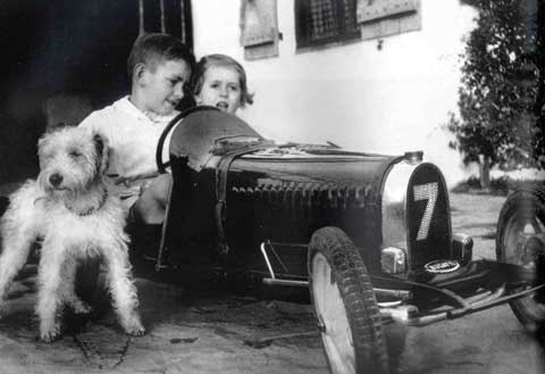
Jackie Forrest Greene, his dog and his sister with the Baby Bugatti number 7. Jackie's father Eric won the 1928 500 Millas Argentinas with a Type 35, also number 7. Photo courtesy Lao Iacona and from the book 'Bugatti Argentina'.
So, provided I can scrape together the required $60,000 or more to put me in the drivers seat, and as long as I exercise and keep away from too much Brie and wine I’ll be able to fit into it. I’ve been told (too often) that I happen to be “perfect race driver size” a.k.a. “vertically challenged.” Granted there might also be a few drawbacks to owning and driving one of these. It ain’t fast, figure somewhere in the range of 10 to 12 mph, I won’t be able to license it for road use, and the biggest hurdle will be that I’ll probably have to wrestle it away from my seven year-old daughter every time I want to take “my Bugatti” out for a spin.
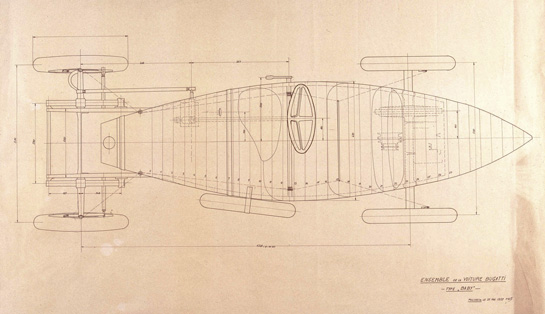
Julius Kruta of Bugatti Automobiles SAS provided this rare factory drawing of the Baby Bugatti. In the lower right corner it reads 'type, Baby'. Note the rear axle. The battery was placed under the hood near the steering column.
I’ve always been fascinated by any half pint car, especially the Bugatti. My first encounter with one in the flesh (actually it was two of them) was in 1998, at the home of the late Allan Stone. He was a well known art collector and gallery owner of note, as in “Allan Stone Gallery” which still exists on the upper East side of New York City. Mr. Stone was also a serious car enthusiast and had a few Bugattis in his garage as well. I was curating a model exhibition then, titled: “The Art of the Automotive Model” for the Stamford Museum in Stamford, Connecticut. It was a little bit of a stretch on the “model” theme to include one of these ‘Baby’s’ in the exhibition since it really is not a model car, however; an important member on the Museum’s board of Directors, Michael Graham, himself a serious collector of cars and models really wanted us to accommodate with inclusion of the ‘Baby’….. so we did.
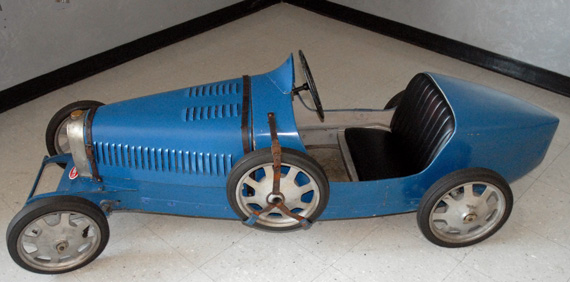
The Simeone Foundation also has a Baby Bugatti on display. It appears to be in very good original condition and there is a set of correct tires waiting to be mounted. This is chassis number 219A. Photo by Harry Hurst.
My visit to Stone’s huge house was truly overwhelming. It was packed to the rafters with art and artifacts of all kinds and sizes (an insurance company’s nightmare). One could get lost in the house and not be found for weeks, maybe even months, and if they found your body, it could very well have been mistaken for some piece of avant garde art! I felt a little like Indiana Jones, during my dig inside his house. I vividly remember finally catching a glimpse of the light blue coachwork of one of his ‘Baby’ Bugs, and that in my excitement, as I attempted to climb over various antiques to get to it, I smashed my head on one of several low hanging Alexander Calder mobiles. I saw stars, and…… then a ‘Baby’ Bugatti in fantastic original, unmolested condition.
Since then I’ve seen several of Ettore’s ‘Baby’ Bugs in person; all in various states of condition, ranging from barn find neglect to original with great patina, and even to over restored a-la Pebble Beach.
Homework: Baby Bugatti
When I was asked to write about these ‘Baby’ Bugattis, I knew right from the start that my knowledge on them was limited as was the scant information in my archives. I was going to have to do some digging, which I did, and there may still be more to discover than what I have come up with. I approached this in the same manner as when I research cars for my own CMA model production runs….. I read what I could find, and then made a mad dash to contact the experts. I am grateful for the help and information provided to me by: Richard Day, Curator of The Bugatti Trust in England www.bugatti-trust.co.uk; Fred Simeone of The Simeone Foundation Automotive Museum where they have a ‘Baby’ on display www.simeonefoundation.org; Julius Kruta who is the Head of Tradition and marque historian for Bugatti Automobiles S.A.S. www.bugatti.com; Sandy Leith who is the Registrar of the American Bugatti Club www.americanbugatticlub.org; and Donald Koleman, President of Competition Motors Ltd. www.competitionmotorsltd.com. With their help I have attempted to piece together most parts of a small, yet confusing puzzle. One of the biggest chunks of that puzzle was that the the Baby Bugatti, long hailed as the Type 52, was not.

Our thanks to Fred Simeone for sending us a scan of the front cover of the original Factory Brochure. Again, no mention of the Type number.
But, but, you must be mistaken!
Some of you may have noticed that I did not refer to the aforementioned ‘Baby’ Bugatti as anything but that. I made no reference to any Type 52 designation simply because….well…..it is not. I used to think this 1/2 scale car was a Type 52, but I was wrong as is anyone else referring to them as such. Yes, I said that, and yes I know that historically everyone has called this 1/2 scale car a Type 52, however that is incorrect. The official designation per all factory records is Type ‘Baby.’ I am told that this enlightenment regarding the official designation has only come about within the past ten years. Allow me to explain. During the recent past, Bugatti Automobiles has opened up its vast files from Molsheim for research to historians whom are the recognized as the foremost authorities in the world. This has allowed many more important pieces of information to surface, and for some corrections to now be made. ALL documentation and literature from the factory actually calls them Type ‘Baby’. On the cover of the only official factory brochure for this model it is clearly and proudly labeled: TYPE ”BABY” On all factory drawings and records including sales records this model is only referred to as ‘Baby.’ Note that on the factory drawing shown, it is clearly labeled Type ‘Baby.’ Nowhere is there any reference at all, as to these children’s cars being designated a Type 52. Thank you Fred Simeone for supplying the copy of the brochure and another thank you to Julius Kruta for supplying the copy of the drawing.
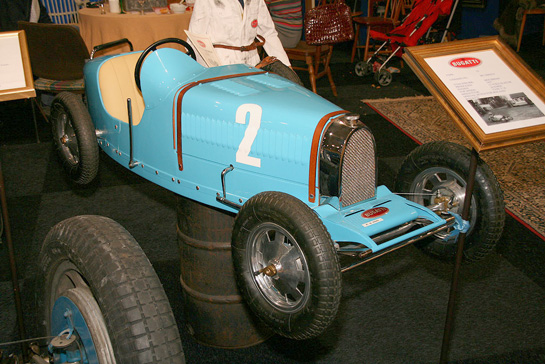
Hugues Vanhoolandt found this Baby at the Maastricht International show. Wheels and tires do not appear to be original but it does look spiffy. Probably a full restoration.
The unfortunate perpetuation of the name myth can be blamed on so very many articles and books written over the years proclaiming the Type 52 designation, which all of them have done with absolutely no documentation to substantiate it. Everyone seems to have taken the given T-52 designation on face value alone.
The first clue that something was amiss at Molsheim was that at Bugatti, a Type number was always given when a project was conceived. If one checks the original documentation and dates of other Types conceived you will see that the Type 52 designation would be clearly out of sequence for the date of its conception as well as for those of the Type 51 which is from 1930-31 and the Type 53 from 1932. That would mean that if the ‘Baby’ were truly a Type 52 (which it is NOT) then its conception date would have to be around 1931, not 1927 as it was. And again, all records list these as ‘Baby.’
I’m cracking open the cognac now, would anyone care to join me? Go to your bookshelves and consult “The Bugatti Story”, by L’Ebe Bugatti, First U.S. edition, Chilton, Philadelphia, 1967. Look in Appendix 1, the 74 types of cars built at Molsheim. There it is, Type 52, right after the Type 51 of 1930 and the Type 53 of 1931. Fine. Except the T52 was clearly first constructed in 1927.
Did the mistake then begin with the daughter of Ettore Bugatti?
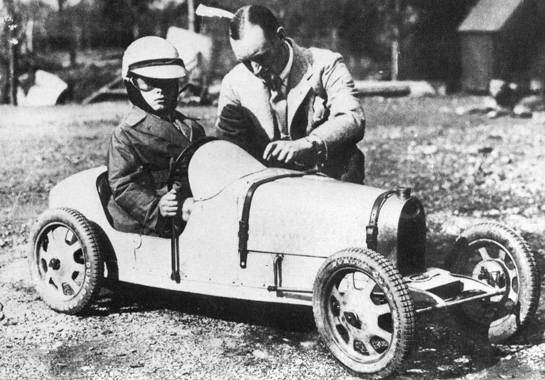
British Speed King Donald Campbell practices his craft in his Baby Bugatti. Campbell would set many speed records both on land and water but died in a speed boat record attempt in 1967. His father Malcolm, also a Land Speed Record holder assists. Photo courtesy the Bugatti Trust.
Part II The Mystery Deepens. Coming soon to a pc near you.
A note about The Bugatti Trust. Simply put, I could not have written this to the extent that I have without their help and access to information, and photos contained within their archives. They are an amazing and highly recommended resource for both enthusiasts and researchers. Housed within their facility is a phenomenal collection of information. If you happen to be a nut for historic photos as I am, then set aside a couple of days for viewing all of them, even better is that you can purchase copies. www.bugatti-trust.co.uk
About Marshall Buck

Marshall Buck founded Creative Miniature Associates, Inc. in 1982. Since then he has been involved with high-end automotive miniatures as a collector, model maker, manufacturer, and broker; catering to serious collectors and offering a combination of services not found anywhere else. A great deal of investigative research, some of it exhaustive goes into producing and building historically accurate models to the level he is well known for.
Marshall has authored a number of articles on models for various publications and wrote a featured model column for Vintage Motorsport magazine from 1988 to 1999. In 2007 he started hitting the keyboard again for Sports Car Market and Corvette Market magazines, and now has joined VeloceToday.
Growing up in the USA and Europe, he was immersed in art and culture from childhood, his parents were collectors of fine art and antiques, which gave him his appreciation for quality and craftsmanship. From the age of eight onwards he was always building model kits.
After his education, he held various positions in professional photography, then television production on various TV shows, and onto the post production management side. During all this time he was honing his model making skills while custom building model cars for himself, and for a few select customers, one of whom was an extremely well known car collector and part owner of Aston Martin Lagonda Ltd. In 1982, that client convinced and funded Marshall to go into model making full time. He took time off from the model business in 1986, doing a three year stint with Miller Motorcars; and in 1989 he went back to model making full time. Since then, he and his models have garnered much publicity and praise world wide – some of which even brought him a personal visit from David Letterman. Marshall’s client list is a virtual who’s who of some of the most well known car enthusiasts around.
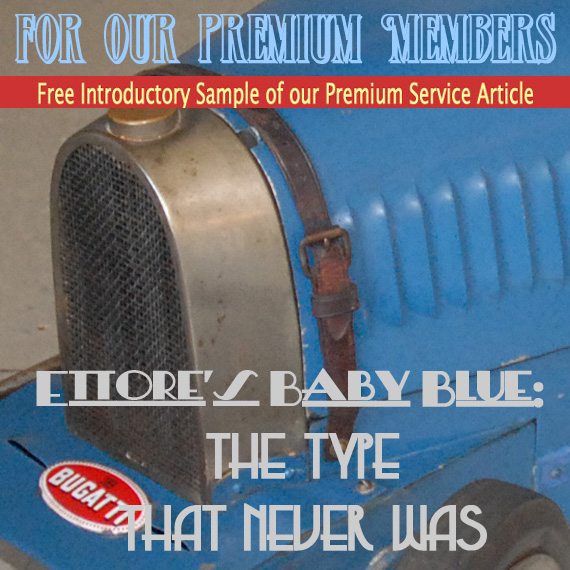
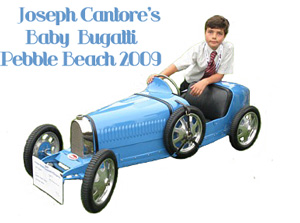
Outstanding article !
Always loved the little car
and now I actually know something about it !
Congratulations…
Marshall,
Thanks for an excellent and well-researched story . . . which does raise a question or two. Such as: Ettore Bugatti certainly numbered every project, back to the very beginning and his Type 1, the Prinetti & Stucchi Tricycle of 1899 (Borgeson has a picture of Bugatti’s cigarette case with the early numbers recorded with a stylus of some sort). It seems unlikely Bugatti would have skipped over 52 in his own project list.
Conway’s “Bugatti Magnum” devotes two pages to the “Type 52” and mentions how the original was a toy constructed for Roland in 1927. That car was much admired, and Ettore decided to put it in production (at an unspecified later time) with perhaps 100 or so built. Could that production have been the time when the Type 52 was an appropriate number?
The factory brochure seems to be exceedingly rare – apparently Conway was unfamiliar with it at the time he wrote “Bugatti Magnum” (and other material, as he uses the Type 52 designation). Could the “Baby” have been Roland’s car, as it was intended for production, but that name/designation was changed before/as it actually was produced? I think your facts shoot this story down before it ever gets off the ground.
So, a great, ground-breaking story. I just wish I knew to what project/car Ettore assigned the designation of Type 52. This was a time when he was doing electric carts, airplanes, boats – is there some other interesting concept in those files?
My understanding is that Mlle. Bugatti drew much, if not most, of her technical information about the Bugatti cars from Hugh Conway. I notice that her photo of Roland Bugatti in “Baby,” in a cut-off photo of Jean Bugatti and the Type 43, has a caption that reads, “Jean Bugatti in a Type 43 model. An electrically propelled half-scale model had been built for his younger brother, Roland.” There is no mention of T35 either, though “Baby’s” parent might be obvious. The photo is from her collection. Appendix I, which is an inventory of the types and their data, is the one place where “Baby” becomes a T52. Rob Roy painted a canvas of himself “dans sa 43 et Roland dans sa 52.”
What a fascinating mystery about the lost T52, especially in light of Ettore Bugatti’s meticulousness about numbering the types! Maybe Mr. Conway, in behalf of Ettore, simply could not leave a vacancy in the inventory, and, as Mr. Seibert suggests above, inserted “Baby” where he thought by planned production date it might occur. Unless the now accessible archives reveal the solution, an enterprising writer might have a solid mystery plot going.
Hmm.
I appreciate Mr. Buck’s research, its documentation, and the path it creates for the subsequent researcher.
Great article, but I do not think the cat is out the bag yet on this. More research is needed, and I would give it time to ”cook” with more discussion.
Ever examined one of these? There are part numbers everywhere – so I am sure there was indeed a production inventory number used for the actual ” bugatti item”. Having studied early 20th century machine workshop numbering systems, accounting, and inventory control used in ALL European machine businesses, there was a common ”given” to the assignment of numbers to production inventory, by model and by parts. It also fits into a mathematical system of record keeping – and it was logical. For so many years the ”experts” dis-spelled logical sequences in numbering. So much BS is out there from experts who never read the early ”manufacturing” norms that ALL of these manufactures used in production – even the ”crazy” Italians were nearly SWISS in there record keeping – all the way up to Enzo. In the past 25 years many ”opinions” have superseded facts and this has created ”Holes” in facturing in excuses for ”missing” numbers ” or a ” mystery number” for ”replaced frames”, when a car was buried or destroyed. This drips onto Touring parts becoming Grand Prix Parts , thus making average cars look more important to the ” no clue investor”. Sorry for drifting off the track there on the little bebe Bugatti. I did see the one sell in Paris last month – unrestored- for $78,000 ! a real sale !
Thank you David and Pat. I truly appreciate your comments and interest. I too would love to know what the Type 52 designation should be assigned to. It is a glaring gap. Perhaps someone will pursue this and continue to dig a lot further.
Very interesting and informative article, Marshall. The only thing I would quarrel with is your remark “over restored a-la Pebble Beach”. One of the first things I say in every judges meeting is “We do not deduct for evidence of use, but we do deduct for over-restoration; cars are meant to be driven”. Some great cars have lost out on class awards in my years as Chief Judge as a result of deductions for over-restoration. It may seem a tough stance to some, but we are all temporary custodians of history. As I tell my judges, “We are all going to be gone, the cars will still be here, let’s leave them right”.
Ed, thank you; I appreciate your comments. I understand and agree with your position on the judging criteria at Pebble Beach, and I applaud your emphasis on the cars being meant to be driven, and the awarded and deducted point scoring emphasis. That is, and always has been my personal philosophy too. I also appreciate the great effort that goes into the restorations of all the cars being shown regardless of whether or not some are over the top. That said, my remark about “over restored a-la Pebble Beach” is simply based on the fact that so many people world-over automatically think of and refer to over restored show cars as “Pebble Beach restorations.”
had a painting at a allan stones gallery in the sixties.he was a real nice guy.not like a gallery owner at all.all the artists liked him.an unusual situation for a gallery guy.should have known he was a car guy but didnt at the time.
If there is anyone seriously interested in an original old 4 page Baby Bugatti (Voiture Electrique) brochure, I have one for sale in near mint condition. It not only shows pictures from this rarity but also shows what’s underneath the body / specifications / wiring diagram etc.
It measures 275 x 210mm. Front page shows the Baby Bugatti, 1st & second page inside, all cars specifications / wiring diagram / front & rear axle with numbered parts / conduite de la voiture (driving manual) with numbered parts from the battery – back from the dash – front from dash / rear page shows a little kid in a Baby Bugatti and a picture from a Baby Bugatti next to a Torpedo Gran Sport type 43. All text in French.
Please make me a serious offer.
Hello Rolf
I’m interested in the original Baby Bugatti brochure.
Please send me an e-mail with the price of it!
Kindest regards,
D.
I’m interested in the original Baby Bugatti brochure and drawings
.
let me know if you have something available and price of it.
Thanks, best regards
Fabrizio C. Sebregondi
Fabrizio,
Unfortunately we do not have the factory brochures. Have you checked eBay?
Editor
I own the Allan Stone Baby. I bought it from Sladmore Gallery in Lodon,
that specializes in Rembrandt Bugatti sculptures,they traded it with Allan Stone.
I am very pleased with it, it even has the original Dunlop Juvenile tyres of 1928.
There is a secret mark to recognise if the car is genuine,but of course i cant tell here.
I also own the brochure and have the 43 in the collection to match with the Baby.
I think the Maastricht car is a Crostwaithe & Gardiner copy.
I am still looking to buy an early short version of the Baby.
So if anyone has one for sale?